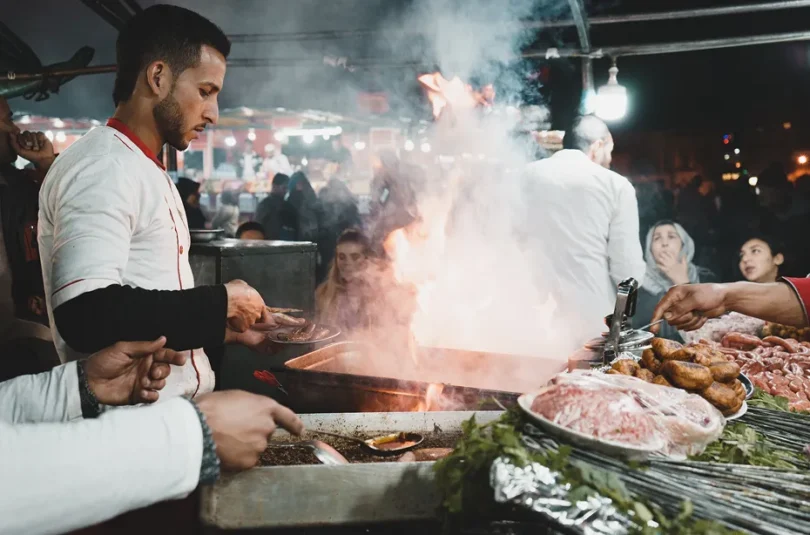Introduction – When the Square Awakens
At sunset, the last call to prayer drifts across Marrakech. The sky over the Koutoubia Mosque turns copper, and Jemaa El-Fnaa — the city’s legendary square — begins its nightly transformation. The storytellers pack up, snake charmers disappear, and an army of cooks, servers, and stall owners moves in. Within minutes, the empty plaza becomes a sea of smoke and light.
Metal counters unfold, lanterns are lit, and the scent of cumin, coriander, and charred meat fills the air. What was a quiet square by day turns into one of the world’s most animated dining rooms, part kitchen, part carnival, part community ritual.
Smoke and Sound
The first thing that greets visitors is not sight but sound. Knives tapping against steel, oil sizzling on iron plates, the rhythmic calls of vendors competing for attention. Somewhere in the background, a guembri hums beneath the pulse of hand drums.
The air thickens with smoke: lamb skewers grilling over charcoal, sardines crackling beside stalls of fried potatoes, steam rising from clay pots of harira. The chaos is choreographed. Each stall has its rhythm, its regulars, its unspoken rules.
To eat here is to stand inside Marrakech itself — noisy, fragrant, alive.
A Geography of Flavor
Jemaa El-Fnaa is a map made of taste. Near one edge, stalls serve brochettes of lamb, chicken, and liver brushed with saffron and paprika. In another section, great bowls of snail soup simmer beside displays of boiled eggs and chickpeas.
Further down, you find couscous and tanjia — slow-cooked meat baked in clay jars inside communal ovens. Fruit-juice vendors line the square with oranges stacked in pyramids, offering a glass of cold sweetness for a few dirhams. And in the heart of it all, mint tea is poured high into glass cups, steam glowing under the lights.
Every corner has its flavor, and every flavor has its story.
The Ritual of the Stall
Beneath the apparent chaos lies discipline. Vendors arrive hours before sunset to claim their numbered spots, passed down through generations. Grills are cleaned, spices arranged, aprons tied. When the first flame is lit, everything must be ready — the crowd will not wait.
Each stall works like a small orchestra. One person fans the coals, another assembles plates, another calls out greetings. The best stalls balance speed with warmth, serving hundreds of meals while remembering returning faces. It is food service as rhythm, practice turned into poetry.
People of the Night
Behind each counter stands a story. Some vendors have cooked here for forty years, inheriting their stall from a parent or uncle. Others came from villages near the Atlas Mountains, bringing their own recipes and finding community in the smoke.
There are rivalries, of course, but also respect. The market thrives on connection — between cook and guest, between neighbor stalls, between old tradition and modern flow. The young apprentices who fan the flames tonight may lead their own stalls in a decade.
At Jemaa El-Fnaa, longevity is success, but consistency is art.
Beyond Tourism
For all its fame, the square still feeds the city itself. Long after tourists return to their riads, Marrakchis gather for late meals — mechanics, drivers, night guards, students. They know where to find the best tanjia, the crispiest fries, the most generous cup of tea.
The market remains local because its rhythm is authentic. Prices shift but the atmosphere doesn’t. You can still share a bench with strangers and eat with your hands, using bread to scoop sauce from a communal dish.
The square belongs to everyone who steps into its light.
Conclusion – The Living Theater of Marrakech
By midnight, the smoke begins to thin. Vendors wipe down their counters, musicians pack their drums, and the square grows quiet again. Only the scent of grilled meat lingers in the air, along with the echo of laughter.
Jemaa El-Fnaa is more than a market — it is a performance without stage, a meal without walls. Its energy does not depend on spectacle but on the rhythm of work, hospitality, and repetition. Every night, the same transformation happens, and every night it feels new.
In the heart of Marrakech, food is not just eaten — it’s lived.


Leave a Reply